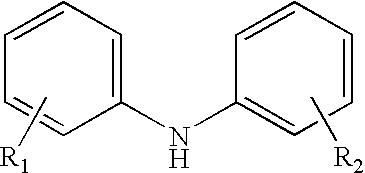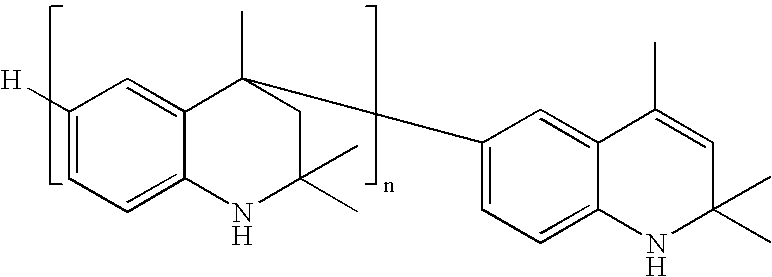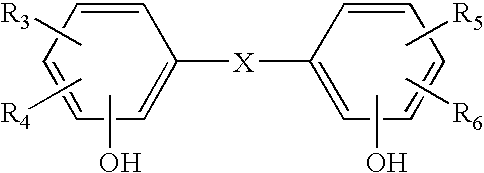Stabilizing compositions for lubricants
a technology of stabilizing compositions and lubricants, applied in the direction of lubricant compositions, base materials, additives, etc., can solve the problems of loss of designated physical and tribological properties of lubricants, lubricants such as those used, and susceptible to oxidative deterioration, so as to achieve unique synergy and improve performan
- Summary
- Abstract
- Description
- Claims
- Application Information
AI Technical Summary
Benefits of technology
Problems solved by technology
Method used
Image
Examples
example 1
[0075]Table 3 lists the chemical properties of the antioxidants selected for testing. Depending on the test program and lubricant formulation, other additives such as antiwear agent, detergents, dispersant, pour point depressant, viscosity index improver, metal deactivator, corrosion inhibitor etc. were also used.
TABLE 3Chemical names and descriptions to the antioxidants selected in this studyIdentificationChemical nameElementalDurad AX182,2′-thiobis(4-methyl-6-tert-butyl-8.5 wt % Sphenol)Naugalube-438LNonylated diphenylamine3.5 wt % NNaugalube-640Butylated, octylated diphenylamine4.2 wt % NNaugalube-5313,5-di-t-butyl-4-hydroxyhydrocinnamic—acid, C7–C9 branched alkyl ester
The base oils selected for this study included a solvent refined API Group I base stock, a hydrocracked API Groups II and III base stock obtained from different refineries in the U.S.
[0076]Blends were made by adding additives to the specific base oils and mechanically mixing at 65° C. for approximately 15 minutes u...
example 2
[0092]Table 10 shows the relative oxidation stability results obtained by adding certain aminic and phenolic antioxidant blends to Group I and Group III base stocks.
TABLE 10Relative Oxidation Stability Results in Group I and Group II BaseStocks (Minutes)AntioxidantsBase StockAminicPhenolicGroup IGroup II——2525—Durad AX15107278—Durad AX16137623—Durad AX32120270Durad AX55—300741Durad AX57—3201140Durad AX15 is 2,2′-thiodiethylene bis [3-(3,5-di-b-butyl-4-hydroxyphenyl) propionate.Durad AX16 is 4,4′-thio bis(2-t-butyl-5-methyl phenol).Durad AX32 is tetrakismethylene (3,5-di-t-butyl-4-hydroxyhydrocinnamate) methane.Durad AX55 is octylated / styrenated diphenylamineDurad AX57 is butylated / octylated diphenylamine
[0093]The five antioxidants are present at a 0.5% treat rate.
[0094]The relative oxidation stability of the various lubricant base stocks is determined by the rotating pressure vessel oxidation test (RPVOT), ASTM test method number D 2272. The oxidation stability is assessed as the li...
example 3
[0103]Table 12 shows the relative oxidation stability results obtained by adding certain aminic and phenolic anti-oxidant blends to industrial turbine oils utilizing a Group II or a Group III base stock. With the type of antioxidant varied in the final formulations, all other additives, including a metal deactivator, a corrosion inhibitor, and a defoamer in the turbine oils remained the same and were kept at a constant level.
TABLE 12Relative Oxidation Stability Results (Minutes) for Turbine Oils UtilizingGroup II and Group III Base StocksBaseAnti-OxidantsStock EmployedAminicPhenolicGroup IIGroup III———Durad AX18416488—Naugalube 531200300Naugalube 438L—12701352Naugalube 640—17441779Durad AX18 is 2,2-thiobis(6-t-butyl-4-methylphenol)Naugalube 531 is 3,5-di-t-butyl-4-hydroxyhydrocinnamic acid, C7–C9 branched alkyl esterNaugalube 438L is nonylated diphenylamineNaugalube 640 is butylated-, octylated diphenylamine
[0104]The four antioxidants are present at a 1.0 wt % treat rate. The relati...
PUM
 Login to View More
Login to View More Abstract
Description
Claims
Application Information
 Login to View More
Login to View More - R&D
- Intellectual Property
- Life Sciences
- Materials
- Tech Scout
- Unparalleled Data Quality
- Higher Quality Content
- 60% Fewer Hallucinations
Browse by: Latest US Patents, China's latest patents, Technical Efficacy Thesaurus, Application Domain, Technology Topic, Popular Technical Reports.
© 2025 PatSnap. All rights reserved.Legal|Privacy policy|Modern Slavery Act Transparency Statement|Sitemap|About US| Contact US: help@patsnap.com



